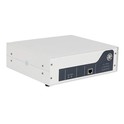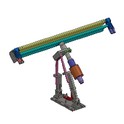Ultrasonic waves have revolutionized numerous industries through their wide - ranging applications, from medical imaging to industrial non - destructive testing. As a leading supplier of universal ultrasonic transducers, we often encounter questions regarding the propagation speed of ultrasonic waves in our products. Understanding this fundamental concept is crucial for optimizing the performance of ultrasonic systems and ensuring accurate results.
Basics of Ultrasonic Waves
Ultrasonic waves are sound waves with frequencies higher than the upper audible limit of human hearing, typically above 20 kHz. These waves propagate through a medium by causing particles in the medium to vibrate. The propagation of ultrasonic waves can be described by the wave equation, which relates the speed of the wave ((v)), its frequency ((f)), and its wavelength ((\lambda)) as (v = f\times\lambda).
The speed of ultrasonic waves is not a constant value; it depends on several factors, primarily the properties of the medium through which the waves are traveling. Different media, such as solids, liquids, and gases, have distinct acoustic characteristics that affect the speed of ultrasonic wave propagation.
Propagation Speed in Different Media
1. Solids
In solids, ultrasonic waves can propagate in different modes, including longitudinal, transverse, and surface waves. Longitudinal waves, where the particle displacement is parallel to the direction of wave propagation, are the most commonly used in ultrasonic applications. The speed of longitudinal ultrasonic waves in solids is given by the formula:
[v_{l}=\sqrt{\frac{E(1 - \nu)}{\rho(1+\nu)(1 - 2\nu)}}]
where (E) is the Young's modulus of the solid, (\nu) is the Poisson's ratio, and (\rho) is the density of the solid.
For example, in steel, which is a common material used in industrial applications, the Young's modulus (E\approx200\times10^{9}\ Pa), the Poisson's ratio (\nu\approx0.3), and the density (\rho\approx7800\ kg/m^{3}). Substituting these values into the formula, we can calculate the speed of longitudinal ultrasonic waves in steel to be approximately (5960\ m/s).
Our universal ultrasonic transducers are designed to work efficiently with different solid media. Whether you are using our transducers for flaw detection in metal structures or for measuring the thickness of solid materials, the knowledge of the propagation speed in solids is essential for accurate measurement and analysis.
2. Liquids
In liquids, ultrasonic waves propagate mainly as longitudinal waves. The speed of ultrasonic waves in liquids is determined by the bulk modulus ((K)) and the density ((\rho)) of the liquid, and is given by the formula:

[v=\sqrt{\frac{K}{\rho}}]
For water at room temperature ((20^{\circ}C)), the bulk modulus (K\approx2.2\times10^{9}\ Pa) and the density (\rho = 1000\ kg/m^{3}). Using the formula, the speed of ultrasonic waves in water is approximately (1480\ m/s).
Our universal ultrasonic transducers can be used in various liquid - based applications, such as level measurement in tanks, flow measurement in pipes, and ultrasonic cleaning. Understanding the propagation speed in liquids helps in calibrating the transducers and ensuring the accuracy of the measurement results.
3. Gases
In gases, ultrasonic waves also propagate as longitudinal waves. The speed of sound in a gas is related to the adiabatic index ((\gamma)), the gas constant ((R)), the temperature ((T)), and the molar mass ((M)) of the gas, and is given by the formula:
[v=\sqrt{\frac{\gamma RT}{M}}]
For air at standard atmospheric conditions ((T = 20^{\circ}C=293\ K), (\gamma = 1.4), (R = 8.314\ J/(mol\cdot K)), and (M = 0.029\ kg/mol)), the speed of ultrasonic waves is approximately (343\ m/s).
Although the applications of ultrasonic waves in gases are more limited compared to solids and liquids, our universal ultrasonic transducers can still be used in certain gas - related applications, such as gas flow measurement and ultrasonic anemometry.
Factors Affecting Propagation Speed
Apart from the medium properties, several other factors can affect the propagation speed of ultrasonic waves.
1. Temperature
Temperature has a significant impact on the speed of ultrasonic waves. In general, as the temperature increases, the speed of ultrasonic waves in most media also increases. For example, in water, the speed of ultrasonic waves increases by approximately (2.5\ m/s) for every (1^{\circ}C) increase in temperature.
2. Pressure
In liquids and gases, pressure can also affect the propagation speed of ultrasonic waves. However, the effect of pressure is usually much smaller compared to the effect of temperature. In solids, the effect of pressure on the propagation speed is even more negligible under normal operating conditions.
3. Frequency
In some media, especially in dispersive media, the propagation speed of ultrasonic waves can be frequency - dependent. This phenomenon is known as dispersion. However, in most common applications, the frequency dependence of the propagation speed is relatively small and can be neglected.
Importance of Knowing the Propagation Speed in Universal Ultrasonic Transducers
As a supplier of Ultrasonic Transducer, we understand the importance of knowing the propagation speed of ultrasonic waves.
1. Measurement Accuracy
In applications such as thickness measurement and distance measurement, the accuracy of the measurement depends on the precise knowledge of the propagation speed. If the propagation speed is not accurately known, the measured thickness or distance will be incorrect.
2. System Design
When designing an ultrasonic system, the propagation speed is a critical parameter for determining the operating frequency, the wavelength, and the size of the transducer. A well - designed ultrasonic system takes into account the propagation speed to ensure optimal performance.
3. Signal Processing
In signal processing, the propagation speed is used to calculate the time - of - flight of the ultrasonic waves. The time - of - flight information is then used to determine the location of defects, the thickness of materials, or the flow rate of fluids.
Conclusion
The propagation speed of ultrasonic waves in a universal ultrasonic transducer is a complex but fundamental concept that depends on the properties of the medium, temperature, pressure, and frequency. As a leading supplier of universal ultrasonic transducers, we are committed to providing our customers with high - quality products and technical support.
If you are interested in learning more about our universal ultrasonic transducers or have specific requirements for your application, we encourage you to contact us for a detailed discussion. Our team of experts is ready to assist you in selecting the right transducer and optimizing your ultrasonic system for the best performance.
References
- Kinsler, L. E., Frey, A. R., Coppens, A. B., & Sanders, J. V. (2000). Fundamentals of Acoustics. Wiley.
- Brekhovskikh, L. M. (1980). Waves in Layered Media. Academic Press.
- Meyer, R. A. (2007). Introduction to Ultrasonic Nondestructive Testing. SPIE Press.




